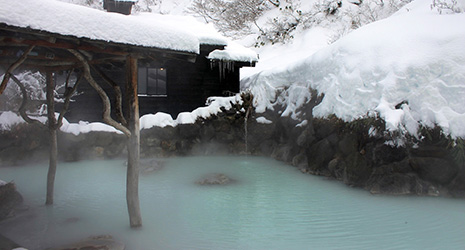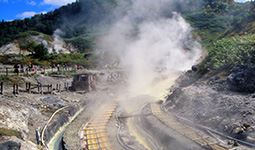Home > Highlighting JAPAN > Highlighting Japan February 2018 > Revitalizing the Regions
Highlighting JAPAN


Hot-Spring Cures for All
Blessed with a beautiful lake and prolific hot springs, Semboku City, Akita Prefecture, has revived a tradition called toji (hot spring cures). The city is now promoting health tourism to hot springs visitors from Japan and overseas.
Located in the central eastern region of Akita Prefecture, Semboku City is famous for Tazawako Lake, surrounded by the glorious mountains and hot springs that dot the area, such as Tamagawa Hot Springs and Nyuto-onsen-kyo Hot Springs Village. The hot springs in Japan are classified into ten types according to their composition or spring quality. “Nine of the ten types of hot spring are available in the Semboku area,” says Naoteru Odano, Director-General for the Regional Revitalization and Comprehensive Strategy, Semboku City. “Visitors to the area can enjoy many different types of hot springs without going anywhere else. That cannot be found in other areas.”
Since the 1970s, Semboku City has promoted green tourism, which means staying at private facilities, such as farmhouses, and experiencing nature and the lifestyle in farming and mountain villages. Users of such facilities were mainly schools, aiming for education in the beginning. Recently, people of all ages including foreign tourists have started to enjoy the healthy meals and mountain hikes offered by green tourism based on the increased awareness of health. In view of this trend, Semboku City established the Council on Promoting Next-Generation Healthcare Industry in 2017. Locals, such as the managers of hot spring facilities, food suppliers and medical experts have taken part in the Council and have started proposing and examining health tourism, adopting balneotherapy.
There is an ancient tradition in Japan called toji, which involves staying in hot-spring areas to take baths, drink spring water and relieve accumulated fatigue.
“Agriculture was the main industry in this area,” says Odano. “Farmers here once shared the custom of taking hot-spring cures in the off-season. They knew from experience that soaking in hot springs relieves fatigue and improves the immune system. These days, few people practice toji, but we would like more people to rediscover its merits.”
Semboku City hopes to promote the health of its citizens and establish a new healthcare industry for tourists by preventing lifestyle-related illnesses and improving health based on a modern version of toji, which combines effective exercise, healthy meals and balneotherapy in an abundant natural environment.
Plans are still being examined by the Council on Promoting Next-Generation Healthcare Industry, but several projects for Semboku citizens have already been launched. One is exercise programs in a municipal hot-spring swimming pool. Such programs have started to show their effects on the citizens that follow them continuously, including a decrease in their body fat ratio.
The system of Hot Spring Bathing Masters certified by the Semboku City Balneotherapy Research Society is another project already in progress.
“The system is aimed at deepening citizens’ understanding of hot springs and promoting safe bathing. Thirty-four citizens who have taken courses offered by the city office have been certified as Hot Spring Bathing Masters so far,” says Odano. “Each year the number of visitors from overseas is growing at hot spring areas in Semboku City. We would like the Hot Spring Bathing Masters to work energetically as concierges in the future, explaining the medicinal benefits of hot springs and the proper way to bathe to tourists from overseas who have never soaked in hot springs.”
On the other hand, Semboku City is facing a problem of a shortage of medical doctors. Many people with various problems visit Tamagawa Hot Springs, which boasts the largest flow from a single fountainhead in Japan at 9,000 liters per minute. These people have expectations for its curative properties based on the fountainhead temperature of 98°C, strong acidity at a pH of 1.2 and peculiar spring quality containing minute quantities of radium. Nurses are on call on a full-time basis at the spa facilities in Tamagawa Hot Springs. However, they are not allowed to provide medical treatment. Visitors have to be transported to a hospital two hours away by car in cases of emergency.
In 2016, Semboku City was designated as a national strategic special zone for regional revitalization where various deregulatory measures are allowed. The deregulation includes a change that enables foreign medical practitioners to work at clinics taking advantage of the advanced clinical training system, not just the designated hospitals to which foreign medical doctors are permitted to provide medical treatment as medical practitioners. This is aimed at facilitating international exchange in the field of medicine and enhancing a sense of relief on the part of foreigners who visit the hot springs in the area. As an experiment, Semboku City invited a medical doctor from Taiwan in June 2017. He offered health counseling services with a Japanese authorized balneotherapeutic doctor to visitors from overseas at a bathing advisory office at New Tamagawa Hot Springs.
“Semboku City signed a partnership agreement with Taipei City because Tamagawa Hot Springs and Beitou Hot Springs in Taipei City are the only two places in the world where hokutolite containing radium is produced,” says Odano. “Exchanges between medical doctors in Japan studying balneotherapy and their counterparts in Taiwan realized the latest health counseling services.”
Semboku City has revived the once-flourishing tradition called toji by updating and commercializing the practice to suit the times. Semboku City is aiming to transform itself into a destination for the latest in balneotherapy through various initiatives, including deregulation and ambitious exchanges at home and abroad.
© 2009 Cabinet Office, Government of Japan







